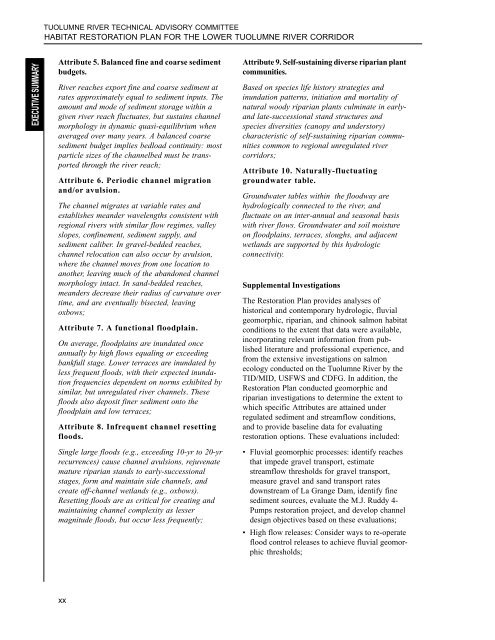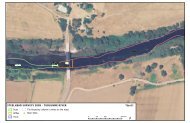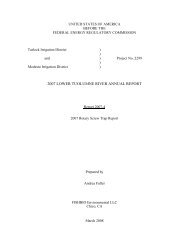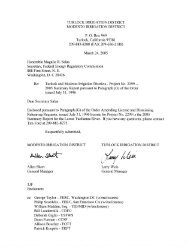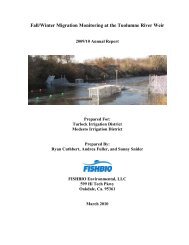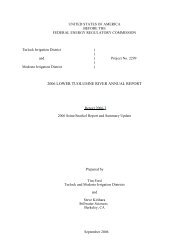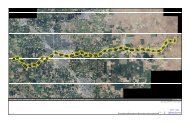Tuolumne River Report - U.S. Fish and Wildlife Service
Tuolumne River Report - U.S. Fish and Wildlife Service
Tuolumne River Report - U.S. Fish and Wildlife Service
You also want an ePaper? Increase the reach of your titles
YUMPU automatically turns print PDFs into web optimized ePapers that Google loves.
TUOLUMNE RIVER TECHNICAL ADVISORY COMMITTEEHABITAT RESTORATION PLAN FOR THE LOWER TUOLUMNE RIVER CORRIDOREXECUTIVE SUMMARYAttribute 5. Balanced fine <strong>and</strong> coarse sedimentbudgets.<strong>River</strong> reaches export fine <strong>and</strong> coarse sediment atrates approximately equal to sediment inputs. Theamount <strong>and</strong> mode of sediment storage within agiven river reach fluctuates, but sustains channelmorphology in dynamic quasi-equilibrium whenaveraged over many years. A balanced coarsesediment budget implies bedload continuity: mostparticle sizes of the channelbed must be transportedthrough the river reach;Attribute 6. Periodic channel migration<strong>and</strong>/or avulsion.The channel migrates at variable rates <strong>and</strong>establishes me<strong>and</strong>er wavelengths consistent withregional rivers with similar flow regimes, valleyslopes, confinement, sediment supply, <strong>and</strong>sediment caliber. In gravel-bedded reaches,channel relocation can also occur by avulsion,where the channel moves from one location toanother, leaving much of the ab<strong>and</strong>oned channelmorphology intact. In s<strong>and</strong>-bedded reaches,me<strong>and</strong>ers decrease their radius of curvature overtime, <strong>and</strong> are eventually bisected, leavingoxbows;Attribute 7. A functional floodplain.On average, floodplains are inundated onceannually by high flows equaling or exceedingbankfull stage. Lower terraces are inundated byless frequent floods, with their expected inundationfrequencies dependent on norms exhibited bysimilar, but unregulated river channels. Thesefloods also deposit finer sediment onto thefloodplain <strong>and</strong> low terraces;Attribute 8. Infrequent channel resettingfloods.Single large floods (e.g., exceeding 10-yr to 20-yrrecurrences) cause channel avulsions, rejuvenatemature riparian st<strong>and</strong>s to early-successionalstages, form <strong>and</strong> maintain side channels, <strong>and</strong>create off-channel wetl<strong>and</strong>s (e.g., oxbows).Resetting floods are as critical for creating <strong>and</strong>maintaining channel complexity as lessermagnitude floods, but occur less frequently;Attribute 9. Self-sustaining diverse riparian plantcommunities.Based on species life history strategies <strong>and</strong>inundation patterns, initiation <strong>and</strong> mortality ofnatural woody riparian plants culminate in early<strong>and</strong>late-successional st<strong>and</strong> structures <strong>and</strong>species diversities (canopy <strong>and</strong> understory)characteristic of self-sustaining riparian communitiescommon to regional unregulated rivercorridors;Attribute 10. Naturally-fluctuatinggroundwater table.Groundwater tables within the floodway arehydrologically connected to the river, <strong>and</strong>fluctuate on an inter-annual <strong>and</strong> seasonal basiswith river flows. Groundwater <strong>and</strong> soil moistureon floodplains, terraces, sloughs, <strong>and</strong> adjacentwetl<strong>and</strong>s are supported by this hydrologicconnectivity.Supplemental InvestigationsThe Restoration Plan provides analyses ofhistorical <strong>and</strong> contemporary hydrologic, fluvialgeomorphic, riparian, <strong>and</strong> chinook salmon habitatconditions to the extent that data were available,incorporating relevant information from publishedliterature <strong>and</strong> professional experience, <strong>and</strong>from the extensive investigations on salmonecology conducted on the <strong>Tuolumne</strong> <strong>River</strong> by theTID/MID, USFWS <strong>and</strong> CDFG. In addition, theRestoration Plan conducted geomorphic <strong>and</strong>riparian investigations to determine the extent towhich specific Attributes are attained underregulated sediment <strong>and</strong> streamflow conditions,<strong>and</strong> to provide baseline data for evaluatingrestoration options. These evaluations included:• Fluvial geomorphic processes: identify reachesthat impede gravel transport, estimatestreamflow thresholds for gravel transport,measure gravel <strong>and</strong> s<strong>and</strong> transport ratesdownstream of La Grange Dam, identify finesediment sources, evaluate the M.J. Ruddy 4-Pumps restoration project, <strong>and</strong> develop channeldesign objectives based on these evaluations;• High flow releases: Consider ways to re-operateflood control releases to achieve fluvial geomorphicthresholds;xx


